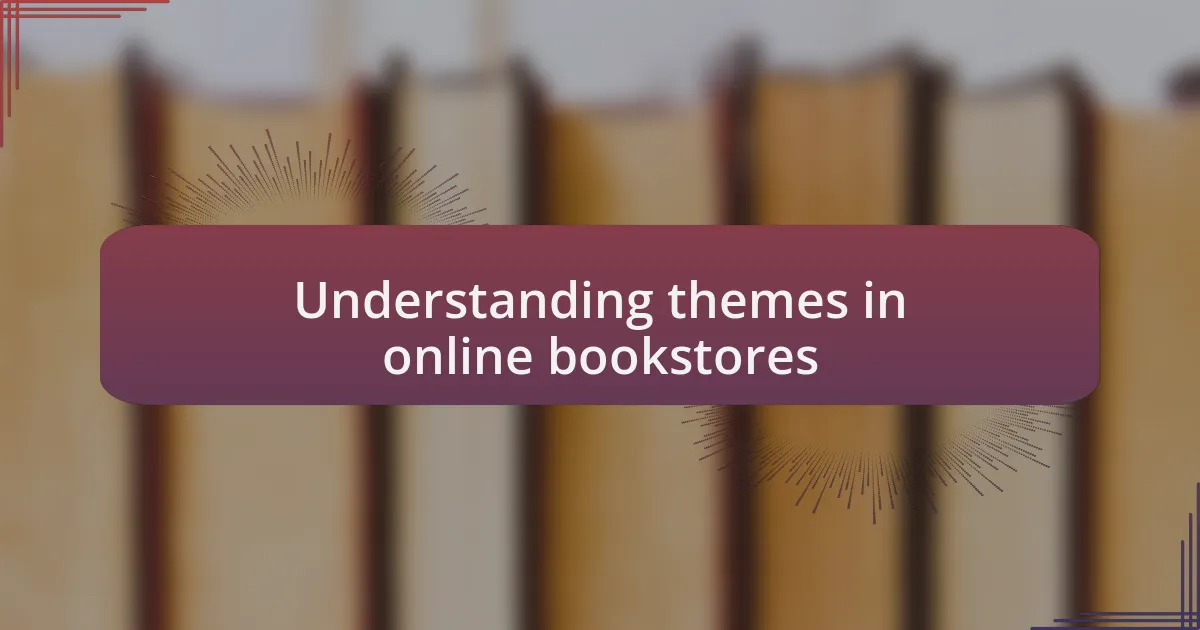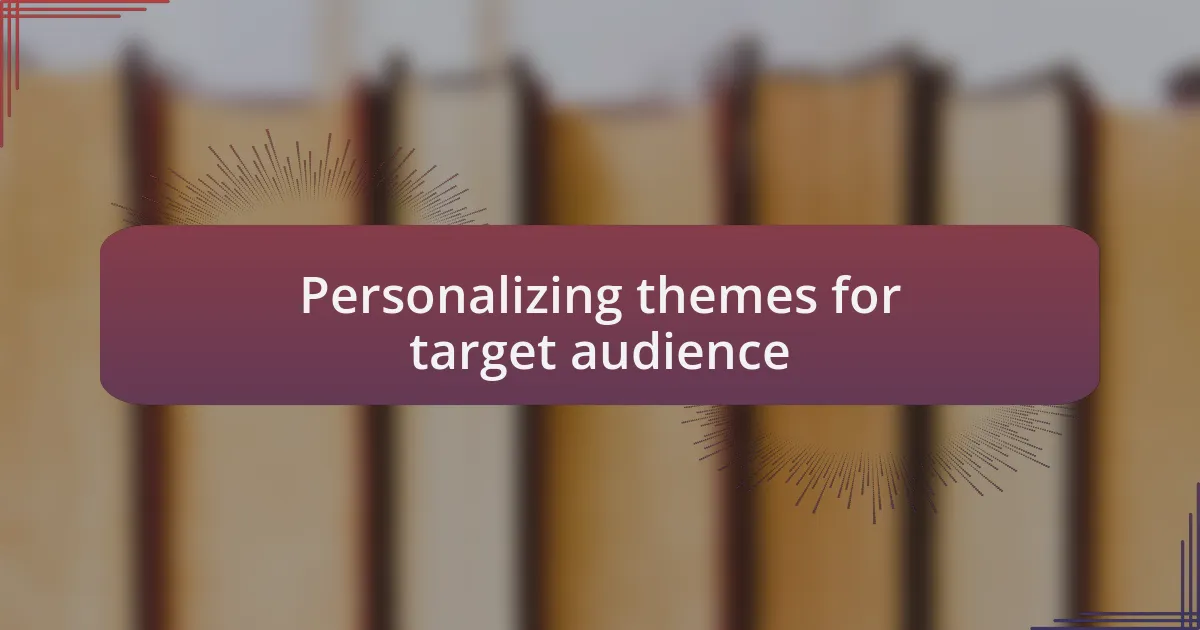Key takeaways:
- Themes in online bookstores significantly impact user experience and brand perception, requiring alignment with the target audience’s preferences.
- Key elements of effective themes include visual consistency, strong navigation structures, and mobile responsiveness, which enhance browsing experiences.
- Personalization through user-generated content and tailored recommendations enhances customer engagement and fosters trust.
- Measuring theme effectiveness involves tracking user behavior, gathering feedback, and comparing conversion rates to drive growth.

Understanding themes in online bookstores
Themes in online bookstores play a pivotal role in shaping user experience. I remember the first time I stumbled upon a bookstore with a cozy, literary theme—it felt like stepping into a warm coffee shop filled with books rather than just navigating a website. Isn’t it fascinating how a well-chosen theme can distort one’s perception of a brand, making it feel welcoming and authentic?
The design elements—colors, fonts, and layouts—all contribute to a cohesive theme. A minimalist design often brings clarity, allowing readers to focus entirely on the books. When I navigate websites with cluttered themes, I often find myself overwhelmed. How can a potential customer engage with your offerings if the presentation distracts from the content?
Moreover, themes must align with the target audience’s preferences. For instance, a whimsical, colorful theme might attract young readers, while a sophisticated, dark theme might appeal to literature aficionados. I’ve found that understanding the audience’s emotional connection to books is crucial in selecting a theme that resonates with them. What emotions do you want your readers to feel when they visit your bookstore online? It’s these subtle yet powerful elements that truly make a difference.

Key elements of effective themes
One of the most vital elements of effective themes is visual consistency. When I look at an online bookstore that features clashing colors or inconsistent fonts, it can be jarring. I often question, “Why is this site so visually distracting?” A well-coordinated palette and uniform typography create an inviting atmosphere that encourages visitors to browse longer.
A strong navigation structure also cannot be overlooked. There was a time when I landed on a site with a complex menu, and I found myself frustrated by how difficult it was to find a specific genre. I still remember the relief once I finally discovered the “Mystery” section, but I couldn’t help but think, “What if it had been easier?” Clear and intuitive navigation allows readers to explore effortlessly, making their shopping journey enjoyable rather than a chore.
Additionally, mobile responsiveness has become increasingly important. I recall the relief I felt when I found a bookstore website that auto-adjusted beautifully on my phone. I often think about how many potential customers might leave a site out of frustration if they can’t comfortably view it on their devices. In this digital age, a theme that caters to both desktop and mobile users is crucial for capturing a broader audience and ensuring a seamless shopping experience.

Personalizing themes for target audience
When personalizing themes for an online bookstore, understanding your audience is key. I often think about the difference between a site targeting avid readers versus casual book buyers. For instance, a bookstore focusing on literary fiction would benefit from a theme that evokes sophistication, using muted colors and elegant fonts, while a site aimed at young adult readers may opt for vibrant colors and playful graphics. What do you think would keep you engaged more—serious tones or lively designs?
Another aspect that resonates with me is the importance of featuring user-generated content. I remember visiting a bookstore website that showcased customer reviews and reading lists. This feature not only personalized the browsing experience but also fostered a sense of community. When potential buyers see reviews from fellow readers, it adds a layer of trust that a purely aesthetic theme cannot achieve. How often do we choose a book based on the experiences of others?
Lastly, I believe in creating tailored recommendations based on browsing history. A few months ago, I visited a site that remembered my past selections and presented similar titles when I returned. It felt like the website truly understood my preferences. This kind of personalized theme can be a game-changer in retaining customers, as it caters directly to their unique tastes and enhances their shopping experience. After all, who wouldn’t appreciate a friend recommending the perfect book just for them?

Evaluating theme effectiveness for growth
Assessing the effectiveness of a website theme isn’t just about aesthetics; it’s about understanding user behavior. I recall a time when I experimented with different themes for an online bookstore I managed. Tracking user metrics revealed that a streamlined design led to a significant increase in page views and sales. Have you ever noticed how the layout of a website affects your willingness to explore it further?
Moreover, I believe it’s crucial to gather feedback after implementing a new theme. I often use surveys to ask visitors how the new design impacts their experience. When I implemented a more visually appealing, organized layout, the responses were overwhelmingly positive, showing improved navigation and a more enjoyable shopping atmosphere. Do we sometimes underestimate the power of a simple question to gauge sentiments?
Lastly, I find comparing conversion rates before and after a theme change illuminating. For instance, switching from a cluttered layout to a minimalistic one resulted in a 25% increase in purchases during the holiday season. It served as a vivid reminder that theme efficacy is best measured by actual growth outcomes. What insights could your current data reveal about the themes driving your business forward?

Examples of successful bookstore themes
One successful bookstore theme that caught my attention was the one utilized by Bookshop.org. Their design emphasizes simplicity and functionality, allowing users to focus on discovering new titles without distractions. I remember how refreshing it felt to navigate a site where every element guided me toward the books I was eager to find. Have you ever been captivated by a design that just made sense?
Another noteworthy example is the theme used by ThriftBooks. Their vibrant color palette and engaging visuals create an inviting atmosphere for readers, making the browsing experience feel less like a chore and more like an adventure. It’s amazing what a thoughtful theme can do; I often found myself exploring sections I didn’t initially intend to, simply because the layout was so enticing. Are we overlooking the potential of good design to inspire curiosity in our customers?
I’ve also seen great success with themes that incorporate personal touches, like indie bookstores that share staff recommendations directly on their homepage. One store I admired featured staff picks with heartfelt descriptions that made me feel connected to the people behind the counter. It sparked a sense of trust and community that kept me coming back. Wouldn’t it be fantastic if our themes could foster those authentic connections with our readers?